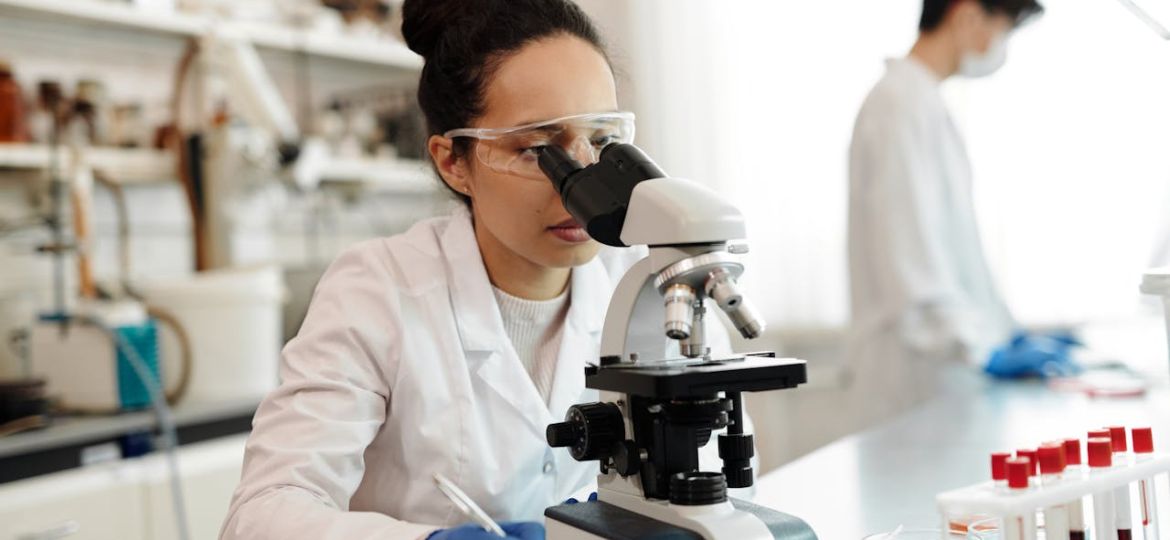
Thematic Issue (Virtuous Science)
by James Brown, PhD; Director, Virtuous Science*
*Saint Albert the Great Institute for Science, Faith & Wisdom
What is Virtuous Science?
Words of Wisdom: All of us should strive to be virtuous in our work. Proverbs tells us, “The just walk in integrity” (20:7), but the complexities of the modern world and science can make this walk both confusing and challenging. We must think, study,and pray to discern the best moral path for our scientific work.
A HUMBLE APPROACH TO VIRTUOUS SCIENCE
The Saint Albert the Great Institute (SAGI) has an incredibly bold, aspirational mission that both inspires and humbles me. I am honored to participate as the Director of Virtuous Science, and I have been occupied by a particular part of the mission –– the “cultivation of the virtues of science”. As we begin our journey, we must seek to understand what we mean by virtuous science. It is my hope that as the Institute grows, we will continually examine our mission, what it means in the world, and how best we can fulfill it.
As is often the case when I begin to think about a topic, I quickly realize that I’m not as smart about virtuous science as I thought I was. The simplest concept is often the best place to start, so I humbly began with the dictionary definition of “virtue”. The common theme in definitions is the concept of a standard, whether of morality, excellence, social value, or other similar desirable quality. A standard requires judgment; either a behavior or object achieves a standard or it does not. Achieving as a standard may not be a purely binary question and a hierarchy may exist: some behaviors or objects are closer to the standard than others. As we begin to think about virtuous science and the basic definitions of the words, we immediately find ourselves counter to the culture. Judgment is often regarded as bigotry, and standards a means of oppression. If the definition of the concept itself elicits a hostile reaction, we can only imagine the challenge of pursuing it –– hence the need for the SAGI!
A TREK FOR WAYS TO DEFINE VIRTUOUS SCIENCE
An increasingly popular step these days in researching a topic is to ask one’s favorite artificial intelligence. I asked Microsoft Copilot “What is the definition of virtuous science?” and it dutifully provided the following response:
Virtuous science refers to the application of moral and intellectual virtues within the realm of scientific practice. These virtues play a crucial role in shaping scientific theories and methodologies.
Relative to this definition, one may delve into this concept further to define the moral and intellectual virtues with respect to science as follows:
1. Moral Virtues in Science:
• Honesty: Upholding truthfulness and transparency in research.
• Integrity: Adhering to ethical standards and avoiding misconduct.
• Open-mindedness: Willingness to consider diverse perspectives.
• Fairness: Treating colleagues and subjects equitably.
2. Intellectual Virtues in Science:
• Testability: The ability to subject hypotheses to empirical testing.
• Empirical Accuracy: Ensuring that scientific claims align with observed data.
• Simplicity: Favoring simpler explanations when multiple options exist.
• Unification: Striving for theories that unify diverse phenomena.
• Consistency: Avoiding contradictions within a scientific framework.
• Coherence: Ensuring internal logical consistency.
• Fertility: The capacity of a theory to generate new insights and hypotheses.
These above virtues guide scientists in their pursuit of knowledge, ethical conduct, and the advancement of human understanding.
These all seem like reasonable virtues that one would want to guide one’s “scientific practice.” There is certainly overlap with Judeo-Christian concepts from the Ten Commandments (thou shalt not bear false witness) and the deadly sins (e.g., pride, envy). Armed with a general definition of virtue as well as a starting point for specific virtues applied to science, the next step, common to any scientific endeavor, is to understand what prior work has been done in the field.
Microsoft Copilot’s definition of virtuous science did not include references to any work in the field, and it was limited to essentially dictionary definitions. I took an “old school” approach and did a simple internet search on “virtuous science”, and the results provided me with helpful websites. These included The Virtuous Scientist Project at the University of Notre Dame. The admirable goal of the “project is to develop a program to ensure scientists in training are made aware of the intellectual virtues during their undergraduate and graduate education.” Their focus on intellectual virtues explicitly presented in their list of exemplars and course descriptions –– attentiveness, carefulness, courage, honesty, humility, open-mindedness, thoroughness, tenacity, and wonder –– is more concerned with what Copilot would call intellectual virtues and less concerned on the moral virtues. This is likely because moral virtue would be addressed more generally in other courses and departments at an institution like the University of Notre Dame.
There are several other sources that discuss virtuous science. The journal Science and Engineering Ethics is “an international, multidisciplinary journal dedicated to exploring ethical issues associated with science and engineering, covering professional education, research and practice as well as the effects of technological innovations and research findings on
society.” An article from this journal, “Developing a Scientific Virtue-Based Approach to Science Ethics Training”, addresses intellectual virtues along the lines of the Virtuous Science Project. A more recent publication “How Do Scientists Perceive the Relationship Between Ethics and Science? A Pilot Study of Scientists’ Appeals to Values”, although citing values, focuses on the conduct of scientific research. “Virtue and the Practice of Science:
Multidisciplinary Perspectives” is a collection of essays that examine virtues through time, “everyday” considerations, scientific education, virtue frameworks, and looking to the future. Like the Virtuous Scientist Project and Science and Engineering Ethics, its focus is on intellectual virtues and how science is executed.
While SAGI is not exclusively Catholic, its namesake reveals the Catholic influence on its founding and current membership. The most notable group of Catholic scientists is the Society of Catholic Scientists (SCS). Less than a decade old, “The Society of Catholic Scientists is an international organization founded in June of 2016 to foster fellowship among Catholic
scientists and to witness the harmony of faith and reason.” The SCS further states:
The Society of Catholic Scientists is an answer to the call of Pope St. John Paul II that “members of the Church who are active scientists” be of service to those who are attempting to “integrate the worlds of science and religion in their own intellectual and spiritual lives.”
In supporting its mission, SCS articles published on its website are mainly apologetic in nature. They address topics such as extraterrestrial intelligence, evolution, and transubstantiation. This is certainly in the realm of virtuous science, as all virtuous scientists should defend the faith and use their talents to show the harmony between God’s creation and what we discover when we seek to understand it.
SAGI’s mission “cultivates the virtues of science” and is aligned within the moral and intellectual virtues as defined by Copilot and faithfully pursued by groups such as The Virtuous Science Project and the Society of Catholic Scientists. Also, SAGI’s mission “advances the power of faith and proclaims the truth, all for the glory of God” and therefore extends beyond these definitions of virtue. Copilot’s virtues and the groups pursuing them focus on how science is done; they do not address what science should do. In the context of the virtuous science that SAGI pursues, questions will not be limited to how experiments are conceived, developed, and executed or how data is collected, interpreted, and presented. SAGI will also ask the most challenging questions –– what experiments should be conducted and what data should be generated.
One organization that addresses the question of what science should do is the National Catholic Bioethics Center (NCBC) which “provides education, guidance, and resources to the [Catholic] Church and society to uphold the dignity of the human person in health care and biomedical research.” The NCBC focuses on the practice of medicine and provides ample resources to support moral and ethical decisions in biomedical research. Another resource is the journal First Things, which describes itself as “America’s most influential journal of religion and public life” and publishes insightful articles on the morality of scientific advances that can inform the conscience. SAGI will “create a renaissance of science and faith” by synthesizing these and similar resources together with the expertise, experience, and devotion to God of its members into new ideas, collaborative discussions, and original publications that engage the scientific community. SAGI will directly address the hard questions, like “What should we be doing to give glory to God?”
There is no more important moral imperative than acknowledging the value of God’s highest creation, human life. All decisions must be made in the context of this highest value. Navigating scientific advances and cultural forces to make the wisest moral decision is complex and often requires careful consideration of many factors that can overwhelm individuals who must make decisions. Recent controversies regarding in vitro fertilization (IVF) show the conflict between a desire to have a family (a moral good), and a method that achieves it which invariably results in the killing of embryos (a moral evil). Scientists can face more nuanced decisions –– if a product or service one is developing can be used for IVF or other immoral purposes, but can also be used for virtuous intentions, is it morally permissible to create it? Karyotyping is commonly used to examine chromosomes for abnormalities. A Catholic colleague of mine worked for a company that did this testing, and he knew that in most cases the information would be used by parents to decide whether to abort a child. Yet, SAGI: The Greatest Experiment • Thematic Issue (Virtuous Science) • Volume 2 • pages 1-4 • 23 March 2024 he was just running a test and providing data. What is his moral obligation? He eventually quit his job as the moral implication was too much to bear.
The Church has provided some advice on these topics that can apply to scientists, such as the Vatican document “Instruction Dignitas Personae on Certain Bioethical Questions.” In the case of using biological material of illicit origin, the document addresses “people of good conscience involved in research” and their “duty to refuse to use such “biological material”
even when there is no close connection between the researcher and the actions of those who performed the artificial fertilization or the abortion.” It further states “in organizations where cell lines of illicit origin are being utilized, the responsibility of those who make the decision to use them is not the same as that of those who have no voice in such a decision.” To coin a phrase, the devil is always in the details. How does one make the proper moral decision when faced with a research project, selling a service, or a collaboration with colleagues that involves material of illicit origin?
A SPECIAL MESSAGE
The purpose of SAGI is to elevate virtuous science. We will address all these questions and more, supporting those who face them and those who may suffer because of their decisions. SAGI members will help one another and provide witness to truth, goodness, and beauty in science. A mainstream cultural answer to the question “Quid est veritas?” is often “Non est veritas”. Contrary to this nihilistic proclamation, SAGI will instead stand with Saint Albert the Great and with Jesus Christ as He proclaims, “I am the Way, the Truth, and the Life.” (John 14:6).



